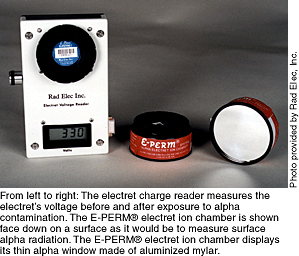

 Rad Elec’s E-PERM Rad Elec’s E-PERM
Alpha Surface Monitor
is catching on
When Initiatives first featured Rad Elec, Inc. of Frederick, Maryland (Fall 1998), the firm was receiving help from the Global Environmental Technology Enterprise in preparing to market passive alpha detectors to DOE sites. The deployment plan estimated that more than 50 percent of DOE sites have a need to quickly and cheaply survey surfaces, soils, debris, and pipes for uranium and plutonium. Rad Elec’s E-PERM® electret ion chamber (Tech ID 2315) uses passive detectors to ensure that decontaminated areas meet residual contamination release criteria. Thanks to GETE and other support from OST’s Industry and University Programs, the technology—which provides improved accuracy and sensitivity to low levels of contamination and reduced cost, personnel exposure, and potential for contamination—is beginning to establish a niche in the market.
The 321-M Fuel Fabrication Facility Large-Scale Demonstration and Deployment Project (LSDDP), sponsored by the Deactivation and Decommissioning Focus Area at the Savannah River Site, demonstrated five improved characterization, decontamination, and dismantlement technologies. In the LSDDP, measurement accuracy and production of the E-PERM Alpha Surface Monitor compared favorably with the baseline hand probe and smear technology. As demonstrated, the E-PERM system costs slightly more but is about 35% more productive than the baseline. The average unit cost per reading for the electret is $2.45, compared to $2.01 for the baseline surveying method. The E-PERM Alpha Surface Monitor offers several other advantages over the baseline:
- simpler to use and analyze;
- smaller size and weight enables posting on floors, walls, and ceilings; and
- less personnel exposure, fatigue, and error.
The technology can measure very low levels of radiation (<10 disintegrations per minute per 100 square centimeters), even in extreme environmental temperatures and humidities.
The SRS LSDDP closed out in December 1999, but the E-PERM electret ion chamber is among three of the demonstrated technologies continuing in use to improve safety and cost-effectiveness as the 321-M cleanup proceeds. Over the past two years, another DOE facility—Ames Laboratory—has been successfully using the E-PERM Alpha Surface Monitor to characterize thorium contamination on surfaces. And preliminary data from a Rocky Flats demonstration has indicated that the Alpha Surface Monitor can be used for characterizing interiors of gloveboxes with very high levels of alpha contamination, a task not easily performed by other technologies. The technology is scheduled to also make an appearance at the LSDDP at Mound, where it will have another chance to show its value in passively monitoring for tritium on surfaces.
For more information about Rad Elec products, visit www.radelec.com, or contact president Paul Kotrappa, (301) 694-0011, pkotrappa@aol.com.
|

